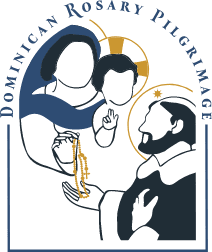At our inaugural Dominican Rosary Pilgrimage, Fr. James Brent, O.P., lifted hearts and minds to the Upper Room—while the historical moment of the Upper Room has passed, the mystery of the Upper Room remains. Mary is still in prayer. And she prays now in a better way, “in the light of glory, in the open vision of God.” And all the voices of heaven summon us from above, beckoning us. “Come, join us around the woman clothed with the sun. Pick up your Rosary. Eyes on Christ. Pray God to send the Spirit of Truth to lead us into all truth.”
Uncategorized
Fr. Peter John Cameron, O.P., Invites You
Fr. Peter John Cameron, O.P., invites you to join us on Saturday, September 30 for the Dominican Rosary Pilgrimage in Washington, DC. Thousands of Catholics are coming together to kick off October, Month of the Holy Rosary.
The Rosary with Fr. Lawrence Lew, O.P.
Br. Finbar Kantor, O.P. has a conversation with Fr. Lawrence Lew, O.P., Promoter General of the Rosary for the Dominican Order on all things Rosary—the benefits of the praying the Rosary; joining the Rosary Confraternity; and on our upcoming Dominican Rosary Pilgrimage in Washington, DC on Sept. 30th.
Where to Begin
For many, the most difficult part of praying the Rosary is simply getting started. Praying five decades can feel like a significant commitment and the number of prayers to say often overwhelms those who struggle to pray the Rosary. Devout men and women who did not grow up praying the Rosary may find the prospect of praying the Rosary to be too daunting and are held back from the numerous riches that devotion to the Rosary affords. Here are a few methods you can use to overcome these challenges and develop your devotion to the Rosary.
Joining in the Parish Rosary
Praying the Rosary with others offers an easy means of eliminating the initial struggles of praying the Rosary. There is no need to fear forgetting the mysteries or losing track of which bead you were on if there are others praying who you can listen to for help. Fatigue from praying is also reduced as many Rosary groups will pray in alternatum (one person or part of the group saying the first half of the prayer and the other part saying the second half). Many parishes have dedicated times for a Rosary before or after Mass, and arriving thirty minutes early to Mass or staying after Mass to pray with your fellow parishioners can be a great means of beginning a devotion to the Rosary. Additionally, the Church offers an indulgence to be gained by those who pray five decades of the Rosary in common.
Praying the Rosary as a Family
If you have children, praying the Rosary as a family can be a great way to introduce the Rosary to your children. This will also open your family to the graces that the Blessed Mother promises to those who accept her patronage. The family Rosary places those who pray it under Mary’s protective mantle and draws the members of the family closer together in love. A helpful way to begin praying the Rosary as a family is to begin with a dedicated day or time to pray as a family. After reading a helpful explanation of how to pray the Rosary, parents can lead their children in prayer by announcing the mysteries and beginning the prayers and having their children respond. Fr. Patrick Peyton, promotor of the family Rosary, preached that the family that prays together, stays together. Beginning to pray the Rosary as a family will form habits of prayer that will have lasting effects on you and your children.
Working Your Way Up
If you find yourself without the time or means to pray the Rosary in common, do not give up! You can begin your devotion to the Rosary in small and simple ways. Carry your Rosary with you wherever you go, hold it in your pocket while you walk. Say one decade as you wait for someone. These small acts can go a long way in developing a familiarity with the Rosary. Soon, you will find yourself meditating on the Rosary as you walk to catch the bus to work, praying a decade while you wait in line at the grocery store, or setting aside twenty minutes to pray a daily Rosary each morning.
Nurturing a devotion to the Rosary in these ways invites the Blessed Mother into your life, along with the many gifts and graces she has promised to those who pray the Rosary. It is a practice that will benefit your whole life and there is no better time to start than today.
Join us on Pilgrimage!
Fr. Gregory Pine, O.P., invites you to join the Dominican Friars for the inaugural Dominican Rosary Pilgrimage, Sept. 30th, at the Basilica of the National Shrine of the Immaculate Conception in Washington, DC. Fr. Pine will give talks on the Rosary and on Our Lady and they’ll be confession, Eucharistic Adoration, praying of the Rosary, and a Vigil Mass. Come on pilgrimage with Fr. Pine and his brothers!
